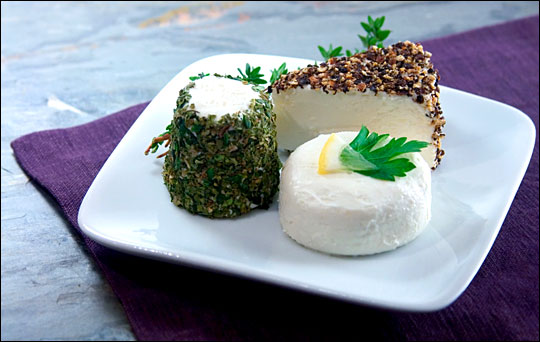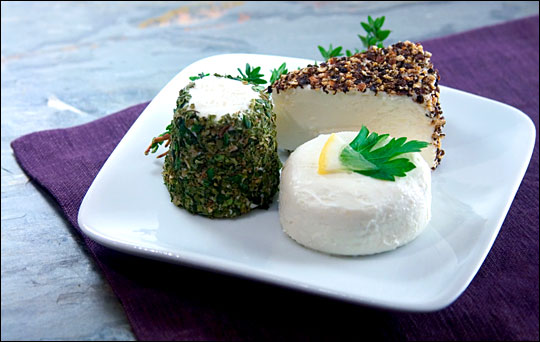In Checkout Line, Lou Bendrick cooks up answers to reader questions about how to green their food choices and other diet-related quandaries. Lettuce know what food worries keep you up at night.

Dear Checkout Line,
In our search to eat local, we’ve uncovered some lovingly handmade local cheeses. They certainly have more variety — sheep, goat, wallaby (well, maybe not wallaby) — and are definitely lots more expensive than the shrink-wrapped yellow plastic squares of cheddar. But are they actually any better for you? Isn’t one half-pound hunk of hard fat just about the same as any other? And are all those dangerous-looking blue cheeses and unpasteurized ones any better for your friendly gut bugs?
Cheers,
Michele and the other cheese-eaters
Dear Michele and the other cheese-eaters,
Thank you for the best segue I’ll ever get in my entire writing life! I’ve been dying to find a way to use this: Did you know that scientists are studying the milk from the Tammar wallaby, a kind of petite kangaroo? As it turns out, wallaby milk packs such an immunity wallop that may be helpful in fighting antibiotic- resistant bacteria, or superbugs.
OK! Let’s move on: As it turns out, hunks of hard fat are not all created alike. Artisan hard fat is unlikely to be preternaturally orange or have additives, emulsifiers, loads of salt, or unfermented dairy ingredients.
“In general, artisan cheeses are healthier because they are not highly processed,” says Jody Farnham, the program coordinator and administrative director for the Vermont Institute for Artisan Cheese. “They are just made with more care. It’s like eating vegetables from your back yard as opposed to having them flown in from California.”
The milk that goes into your local artisanal cheese is also likely to be higher quality. But if it’s not organic, do ask the cheese maker some questions:
- Is your milk free of antibiotics and growth hormones?
- What do the cows/sheep/goats eat?
- How long are they on pasture?
- If they eat grain, what kind do they eat? Is it GMO-free?
(For an in-depth look at questions to ask a dairy farmer, go the Sustainable Table’s “Questions for a Farmer” shopping guide.
If the cheese you are buying is farmstead cheese — made from milk from the cheesemaker’s own herd — you might even be able to take the cheese eaters in your house on a field trip to meet the cheese maker and see the cows/sheep/goats first-hand. If that is the case, then also ask:
- Why is your goat chewing my pants?
Of course, if you can’t go to the farm, ring up the cheese maker or go to her web site. (I say “her” because Farnham told me that many cheese makers are women. This makes perfect sense to me, from a lactational standpoint.)
Now, onto the subject of gut-friendly bugs, or probiotics. Cheese is a fermented food and therefore contains probiotics, the bacterial darlings that are all the rage because they are credited with improving digestive health.
But before we leap to any conclusions, consider that there are many different strains of probiotics and that their health benefits are still being studied. I did find one European study that showed that unprocessed cheddar cheese had friendly gut bugs.
Ironically though, you can now get gut bugs in processed cheddar. As it turns out, live bacteria dairy products are becoming cash cows. This is why Kraft is now selling a “LiveActive” line of processed cheese (including cheddar) to which they’ve added probiotics. Check out this Kraft dramatization, which is so cheesy that it’s mesmerizing. I sampled some of this Kraft cheese and will attest to the fact that it’s cheaper and low fat, but also rubbery, salty, and bland.
It was also likely made from factory-farmed cows that were pumped full of antibiotics and thus helped to create the antibiotic-resistant superbugs that made humans sick — the rise of which in turn has caused scientists in the Netherlands to milk some poor bewildered little kangaroo.
Because you also mentioned unpasteurized cheese — which proponents say tastes better and has more friendly gut bugs — I need to mention that raw-milk cheese must, by law, be aged for 60 days to get rid of any lurking pathogens, which die off as the cheese ages. Here’s the spooky USDA warning, which also includes info on blue cheeses.
Of course, lots of people think this is a load of hooey, and you can find all sorts of online material promoting raw milk here. Perhaps you even have some clandestine raw-milk-cheese eaters in your neighborhood. (Hint: They will be carrying wax paper bundles under their trench coats.)
One last thought on unpasteurized cheese (the aged legal stuff): It might build stronger bones because its calcium is more absorbable. My nutritionist gal-pal Esther Blum advises, “Always look for raw, unpasteurized varieties unless you are pregnant or a small child. Once the cheese is pasteurized, it converts into an ionized form of calcium, which is very difficult to assimilate into the body.”
Bottom line: Enjoy your local artisanal cheeses, which are better for you than the orange stuff, but don’t expect your wedge of Stilton to cure irritable bowel syndrome (not that I’m saying you have that).
I love handmade cheeses, and I don’t give a whit about their saturated fat content (I’m partial to triple-crème cheeses), but for budgetary purposes I eat them sparingly. My approach is to treat fine cheese like fine chocolate, savoring it in moderation. (That sound you hear is my husband laughing. Ignore him.)
Have fun putting together your holiday party cheese plate,
Lou


